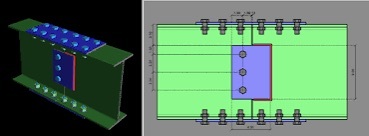Can I-beams be spliced anywhere or should it be like the rebars in concrete beam where it shouldn't be in location of great moments? But if your I-beams are lacking in length.. how do you exactly make the splice coincide with regions of minimal moments?
And what's the best way to splice 2 ibeams pieces?
Also how many have tried the w8x18? what is moment capacity of it? where do you usually use this size? Just verifying some numbers.



